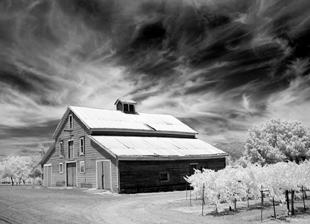Painless Infrared Photography
What kind of eerie world makes the sky go dark and trees turn white? It’s the stunningly beautiful realm of infrared photography.
If you’ve ever tried shooting and processing infrared film, you know what a pain in the aperture it is to deal with. You have to load the camera in complete darkness, guess wildly about the exposure settings, process the film, and then cross your fingers that at least one or two shots turned out the way you had hoped. The results could be stunning, but they came at a painful price.
Digital photography has changed all that. Not only is persnickety film handling a thing of the past, but you also now get to preview your infrared images on the LCD monitor before taking the shot. And the best part? They will look every bit as beautiful as their film counterparts, as you can see in Figure 2-17, which was shot with a Canon G1 digital camera. This barn shot was taken at 1 p.m. Most photographers are diving for cover at this time of day—that is, unless they’re shooting infrared.

Figure 2-17. An infrared shot of a barn
Infrared photography deals with the spectrum of light that you can’t see but that your digital camera can. If you buy a filter to eliminate the normal light rays and capture only the infrared rays, you can add this look to your photographic bag of tricks.
The first thing you’ll notice in infrared photography is that the blue ...
Get Digital Photography Hacks now with the O’Reilly learning platform.
O’Reilly members experience books, live events, courses curated by job role, and more from O’Reilly and nearly 200 top publishers.

